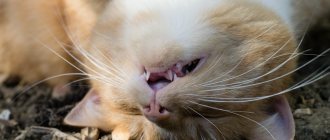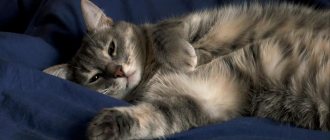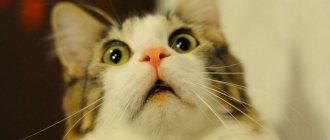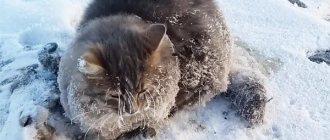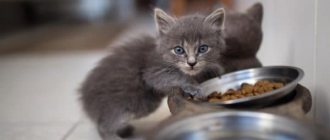A cat’s cough is a natural physiological reaction of the animal’s body to irritation., development of pathology in the respiratory tract. In the process, due to reflexive muscle contraction, accumulations of mucus, pus, blood, as well as foreign bodies are removed.
Usually, the situation when a cat coughs and wheezes at the same time confuses its owner. You need to know how to provide first aid to an animal, and then contact a veterinarian who will solve the problem professionally.
Mechanism of cough development
Usually, the situation when a cat coughs and wheezes at the same time confuses its owner.
A cat’s cough manifests itself specifically:
- the stomach is pulled inward;
- the spine arches in the shape of a question mark;
- the neck is greatly extended;
- the animal's head is pressed to the floor;
- a sharp, loud sound comes out of the open mouth.
The reason for contacting a veterinarian is a periodic or constant cough.
Allergy
An allergy can arise as a reaction to new food, cat litter, or due to “excesses” from the table of its owners. A kitten may suffer from allergies to tobacco smoke, odors of household chemicals, flower fertilizers, and strong perfumes. In this case, it is necessary to trace the animal and identify the source by removing it.
Watch a video about why cats cough.
Sneezing, incessant itching, scratching, wounds, redness of the eyes and ears - this is an incomplete list of allergy manifestations. To confirm this diagnosis, you need to consult a veterinarian. He will help you choose the right diet and necessary medications.
The cat is sneezing and coughing - what to do? Cause: helminthiasis
Sometimes sneezing and coughing are a sign of helminthiasis. There are many ways of infection with helminths. They affect both those animals that roam free, as well as purely domestic ones.
Where do worms come from? A cat is at increased risk if the owner feeds it with village milk or unprocessed thermal products (fish, liver, meat). If the products have been thermally processed, but poorly, then the eggs and larvae of worms may remain alive. Sometimes the owner himself, without knowing it, is the carrier of the disease.
Worm eggs enter the apartment along with contaminated shoes and street dust on clothes. Then the eggs move to the floor where the animals walk. As you know, cats wash themselves with their tongue, and all microbes and larvae enter the body.
The following types of parasites live in the cat's body:
- Tape.
- Flukes.
- Round.
If you miss the moment and do not do periodic deworming, the parasites will multiply so much that they will fill the intestines and move into the stomach, where they will begin to irritate it, causing coughing and vomiting. Often helminths enter the bronchi and lungs, causing coughing. In this case, the cat behaves as if it was choking: it sticks out its tongue and stretches its neck.
Cough during infection and subsequent migration of parasites in the body is more often observed in kittens than in adult animals. Old individuals with weakened immune systems are also at risk.
Read about why a cat vomits after eating. And also about why your cat stinks.
If you suspect helminthiasis, you should take a stool test, after which the exact type of parasites will be determined and the optimal drug for them will be selected. As a preventive measure, you should keep your cat’s sleeping area clean, regularly disinfect its habitat, wash the animal and treat it for fleas. For those pets who go outside for walks, a collar against fleas, the main carriers of parasites, will not hurt.
Types of cough in cats
When a cough appears, pay attention to its external signs:
- Duration of symptoms. A cough lasting several months (years) is considered chronic; an acute course of the pathology is observed in the first few days (week).
- Periodicity. It is necessary to determine the time when the symptoms intensify (in the morning or evening, season of the year, situationally (during meals), etc.).
- The nature of the discharge that accompanies a wet cough. Pay attention to the contents: vomit, mucus, blood.
- The power of the attack. A hysterical, severe cough is dangerous.
- Sound. It can be loud or muffled.
A persistent or severe cough in your pet is a reason to visit a veterinarian.
Allergies as a cause of coughing and sneezing
If your cat sneezes and coughs only periodically, it is possible that some inhaled irritants or specific allergens are affecting the nasal passages. Try to understand what causes the reaction. Maybe it starts after lighting candles at the dinner table? After the cat went to the litter box? After cleaning the house?
Here are examples of such irritants or allergens (microsubstances that cause allergies) in cats:
- alcohol mixtures;
- cigarette smoke;
- insect sprays;
- cat excrement;
- candles;
- cleaning powders;
- dust, as well as plant pollen.
Among cats, allergies are considered a less common problem causing sneezing than in humans. If the problem is related to allergies, sometimes itchy skin and watery eyes are also present.
There are many other factors that can cause cats and cats to sneeze and cough. For example, in animals this phenomenon occurs within four to seven days after receiving an intranasal vaccine. Cats also sneeze to try to clear a blockage in their nasal passages. Inflammation of the tooth root can cause drainage in the sinuses, which again leads to a corresponding reaction. In very rare cases, coughing and sneezing in cats are signs of cancer.
Causes of cough in cats
A persistent or severe cough in a pet is a reason to visit a veterinarian.
Causes of a cough in a cat:
- Viral and microbial pathologies. This cough is called respiratory cough. The pathological process begins with a loud and dry cough, then it turns into an expectorant cough, often accompanied by purulent discharge. The cat's body temperature rises, nasal discharge appears, its eyes fester, and it sneezes. With pneumonia, the temperature is especially high.
- Hypertrophied (enlarged) heart or its individual parts. This is a heart cough. Pressure is applied to the airways located next to the heart, the brain receives information about the pathology, and a cough reflex occurs. At the initial stage, a rare cough is observed, which intensifies over time (as the heart enlarges), becomes more frequent, and the impression appears that the animal is choking and trying to spit something out. There is no sputum.
- Irritation of the walls of the stomach or intestines by parasitic worms. This cough is called invasive. The cat takes a pose typical of coughing, but at the same time sticks out its tongue, exhales sharply, wheezes, then a cough reflex appears with gagging. Along with sputum, foam and parasites are released. In this state, the animal eats poorly and loses weight.
- Trichobezoars . The spasms differ in intensity and are repeated periodically until a hairball (bezoar) comes out of the throat through the gag reflex.
- Internal (appears when swallowing sharp bones) and external (results of fights, falls) damage to the respiratory organs. With minor injury, rare coughing is observed, which becomes more frequent when eating food. With serious wounds, the pet is restless, meows, and has difficulty swallowing food.
- Asthma. Heavy breathing, suffocation, the animal coughs often, sometimes continuously. Asthma attacks are often seasonal and are caused by allergies. Body temperature during an exacerbation remains normal.
- Malignant formations in the respiratory organs. Cough appears at the last stage of the pathology. The animal weakens, experiences pain, and coughs up blood.
Be sure to read:
A cat refuses to eat: reasons, why it’s dangerous, first aid, what to do, how to increase the animal’s appetite
Only a professional can correctly determine the cause of the disease.
Reasons why a cat sneezes
A healthy cat sneezes extremely rarely - once every few days or even weeks. If there is no dust, hair or aerosols in the air, the animal may not sneeze for months. The normal limit is 1-2 sneezes per day. Obvious pathology is sneezing more than 2 times a day, serial sneezing, nasal discharge, the appearance of other symptoms - coughing, refusal to eat, lethargy, fever.
Foreign object
Cats constantly sniff their surroundings and can inhale dust, hairs, particles of litter, threads, even insects. The nasal passages of animals are very thin, so any small object gets stuck in them and irritates the mucous membrane. The cat sneezes to get rid of a foreign object.
You can determine a foreign body in the nose by the behavior of the animal:
- the cat sniffles;
- rubs one side of the muzzle against objects;
- scratches nose with paws;
- sneezes continuously.
A discharge may appear, most often clear mucus. This is part of a natural defense mechanism that helps get rid of a foreign body in the nose. If the mucous membrane is damaged, ichor or blood appears in the discharge.
Cold
Cat colds, like human colds, can be caused by several different types of viruses. The symptoms are also similar to human ones - coughing, constant sneezing, nasal discharge. With a severe cold, a cat breathes with its mouth open, which is why its tongue constantly dries out, and it cannot eat, drink, or smell normally. Temperatures rarely rise, but the nose may become dry and hot due to the cat's inability to lick it regularly.
A cold in animals lasts 3-4 days, then the inflammation subsides. It can be treated at home, the main thing is to provide the fluffy with adequate nutrition and drink. A cat with a cold does not smell food well, so you need to give it familiar, favorite foods. If the animal does not drink for more than one day, you need to give it warm water from a syringe without a needle or from a pipette.
Diagnostics
Having studied the external symptoms of cough, we proceed to diagnosis:
- conduct an external examination of the body, listen for wheezing and noises;
- evaluate cardiac activity;
- take blood for analysis;
- do an X-ray examination of the sternum;
- a culture of secretions or sputum is collected to identify the causative agent of inflammation;
- examine the affected organ for oncology (if suspected).
In clinics, it is possible to examine the entire animal’s body by different specialists and conduct an X-ray examination with a contrast agent.
Why does a cat cough and sneeze? Let’s look at the main reasons
The reasons that a cat sneezes are no less than the reasons for coughing. Treatment also depends on the cause of the disease. So, if it is a fungus, then drugs are used against it. If a foreign body is stuck in the nose or trachea, the doctor must remove it. And so on for each disease.
Here we will look at the main causes and methods of treating them, however, the information is for informational purposes only and it is strictly not recommended to treat your pet on your own.
Upper respiratory tract infections in cats
It is upper respiratory tract infections in cats that become the most common cause of sneezing in cats. There are different types of infections: fungus, bacteria and viruses. The symptoms are approximately the same:
- Kitten sneezes
- Coughs often
- His nose is wet
- Eyes with tears
Allergies in cats
As already mentioned, cats suffer from allergies no less than people. The reasons are the same as for people: dust, strong smoke from cigarettes or hookahs, pollen and flowering, various powders, new tray fillers, the smell of food, air fresheners, etc. In such cases, the cat rubs its nose on the surface, as well as with its paws. A cat sneezes only when it is in an allergenic environment; its nose also becomes wet and a runny nose appears. The pet wants to quickly run away from the place where the attacks began.
If you are allergic only to the litter for the tray, then you just need to change it and the allergy will go away, you don’t need to do anything else. If some allergen gets stuck in the pathways and causes discomfort for a long time, you need to consult a doctor for help. It is also worth noting that the exacerbation begins during flowering periods in the spring and sometimes in the fall, so it is enough just to survive short periods of time and suffer a sneeze, but then it will all end and the cat will feel good.
Asthma in cats
Cats also have asthma. A few words have already been said about it, but in some cases the pet coughs, and in others it sneezes. They are treated approximately the same. The cause of the disease is a long interaction with the allergen, which caused sneezing and now continues to do so on a constant and almost chronic basis. They are often treated with warm steam, which the pet inhales. This helps clear the bronchi of excess.
Heartworms in cats
As you know, mosquitoes are carriers of bacteria and diseases; just remember malaria in Africa. However, not everyone knows that mosquitoes can infect a cat with a simple bite. Microscopic larvae enter the body through the insect's proboscis. Through blood vessels and pathways they enter the heart, or more precisely, into its right chambers. The nearby pulmonary and cardiac arteries are affected, the worms become clogged and make breathing difficult, causing the pet to sneeze. If he sneezes frequently, the arteries become clogged and sometimes a heart attack occurs. The main symptoms here are the cat's sneezing and coughing.
Only a veterinarian who has already encountered a similar problem should treat a pet in such a situation. You can’t ignore it and you also can’t advise anything, because the case is serious and requires equally serious intervention from a specialist. It is better, of course, to carry out preventive procedures to avoid infection in principle.
Dental problems in cats
Sometimes it happens. Yes, this is rare, but if there are any problems with the teeth (smell from the mouth, suppuration, gum disease). The infection that struck and caused these causes also reaches the respiratory tract, which leads to sneezing. This happens to kittens that are still weak and their immunity is susceptible to attack.
How can you tell if your cat is not just coughing, but choking?
An animal can choke if a foreign body, usually small in size, gets stuck in the throat or esophagus.
The following factors allow you to understand that a cat is choking and not sick:
- eating before the first symptoms appear;
- the cat does not take the standard posture for a normal cough;
- there is no cough, but there is wheezing and vomiting;
- touches the muzzle with its paw, tries to remove the disturbing object itself;
- saliva is produced abundantly, it flows abundantly from the mouth, the animal is not able to swallow it.
The presence of these signs indicates that the cat is choking and assistance must be provided.
The cat has a cold and is sneezing: what to do?
If your pet is sneezing, coughing, the nose is dry and hot, the eyes are watery, there is no appetite, breathing is difficult, you should give the cat first aid.
Algorithm of actions:
- Carry out a visual inspection, analyze whether the disease is the result of a viral infection.
- Place the sick person in a comfortable, warm place, making sure there are no drafts.
- Put a heating pad on if the animal is cold.
- Give plenty of warm water and milk. Cold drinks are prohibited.
- Massage your body to increase blood circulation.
- Offer nutritious food.
What to do if your cat is coughing
A cough caused by a cat choking is considered a reflex.
A non-reflex (pathological) cough is a reason to contact a specialist
You can help the animal in the following ways:
- Open your mouth and inspect the mucous membranes.
- When you see a foreign body, try to remove it with tweezers.
A non-reflex (pathological) cough is the basis for contacting a specialist and forces you to provide your pet with certain conditions:
- Fresh air supply.
- Increased humidity in the room. You can use a humidifier, hang wet towels and spray water through a spray bottle.
- Protect from hypothermia.
Before a specialist arrives, it is forbidden to give medications that can change the symptoms of the pathology.
The kitten has a dry and warm nose: what to do?
- The body of a small kitten is very similar to that of a child. He also has a high metabolism. A pet's nose can react to various changes much faster than that of an adult cat.
- And thermoregulation at a young age is still unstable; it has not yet fully formed.
- During the course of a day, your kitten’s nose may become cold, then hot, dry, or wet several times.
This may depend on all sorts of factors:
- The kitten just woke up.
- The pet started playing.
- The baby has recently eaten.
In a kitten The condition of the nose may also depend on what mood the kitten is in.
- Such changes are considered natural, so you should not worry about such an event. But, if the animal shows alarming signs (the mood, behavior has changed, the kitten has become less active), it is necessary to sound the alarm.
- Kittens have dry and warm noses unless their mother licks them thoroughly. The kids themselves cannot do this on their own. In such a situation, help the growing animal. Wipe the kitten's face with warm water several times a day, but it must be boiled.
- The condition of a small kitten's nose can tell you a lot. But his risk of getting sick is much greater if you have not yet had time to vaccinate him. In addition, a dry, hot nose may indicate that the pet has been poisoned. In this case, go to the vet immediately.
Watch the nose Try to pay close attention to such physiological changes in cats. As a rule, they do not signal any serious illness. But there are cases that a dry nose is only the first symptom of a serious illness, and therefore you cannot do without the help of a veterinarian.
Treatment of cough at home
Therapy is determined by the complexity of the pathological process and is aimed at eliminating it:
- For invasive cough, antiparasitic procedures are prescribed, and in the future it is recommended to regularly prevent the disease.
- Attacks due to cardiac problems are eliminated by comprehensive treatment of the cardiovascular system and general cough suppressants.
- The specificity of antiviral and antibacterial therapy is determined by the characteristics of the cough: expectorants are prescribed for dry coughs, and antitussives for wet coughs.
- Asthmatic attacks are stopped by hormonal and glucocorticosteroid, antiallergic drugs.
- Special creams and pastes improve the condition of trichobezoar They cover the surface of hairballs and facilitate their natural release.
- Cough from injuries to the respiratory organs and throat subsides as they heal. If internal organs are injured, the pet is given crushed food. For external wounds, treatment methods depend on the severity of the pathology. In serious situations, the wound is surgically sutured and antibacterial therapy is carried out.
Be sure to read:
Dry nose in a cat: reasons, what should be normal, good or bad, what to do
A sick animal should have access to water, but it should not be forced to drink.
Veterinarians often combine antitussive therapy with immune restoration.
Possible diseases if a kitten sneezes
In addition to the above viral infections, possible diseases that cause sneezing in a kitten can be of a different nature. Unfortunately, the range of diseases is so wide that only a veterinarian can cope with the diagnosis.
The most dangerous are viral diseases, against which the kitten must be vaccinated.
If you pick up a baby on the street or buy it at a poultry market, the resulting viral diseases can cause its death.
Possible diseases of which sneezing may be a symptom are:
- Infectious peritonitis occurs without symptoms for a long time, and at an early stage of the clinical picture it is similar to a cold.
- Feline immunodeficiency virus is a slowly and secretly developing disease that adversely affects the body's immune system. When the cat's immunity level declines, it becomes vulnerable to any, even basic respiratory infections.
- Feline viral leukemia - in the first stages of development, is similar to a respiratory infection, in fact, it is a serious viral disease, which most often leads to death.
- Chlamydia - gives a complete picture of an acute viral respiratory infection complicated by bacterial infection. Unfortunately, chlamydia is highly contagious and common. One of the first symptoms of chlamydia is acute conjunctivitis.
- Mycoplasmosis is common, like chlamydia, contagious, and deadly. Mycoplasmosis progresses more slowly, but leads to more severe consequences: bacterial pneumonia and swelling of the respiratory tract.
Most viral infections cannot be diagnosed with guaranteed accuracy. To detect infection, blood is taken from the cat and examined for the presence of antibodies.
With viral infections, everything is a little more complicated; the causative agents of the disease must be found in the blood sample. This diagnostic method is called PCR. Unfortunately, PCR diagnostics are not available in all clinics and cost a lot of money, so most veterinarians, suspecting a viral infection in a kitten, begin complex, aggressive therapy.
A few words about antitussive drugs
A special group is occupied by anti-asthmatic drugs, which relieve spasms and dilate the bronchi.
Medicines according to the method of action are divided into 2 groups:
- Central action - they block the cough reflex of any nature, they are potent substances (Codeine, Libexin, Glaucine).
- Expectorants - change the specificity of cough, stimulate the accumulation of sputum, thin it and facilitate expulsion (ammonium-anise drops, Bromhexine, Lobelon).
A special group is occupied by anti-asthmatic drugs that relieve spasms, dilate the bronchi (Ephedrine, Atropine, Theophylline) and restore the breathing process.
Specific treatment methods are determined only by a veterinarian based on the clinical picture. The doctor will determine the dose of the medication and prescribe the necessary accompanying procedures. Choosing a medication on your own is dangerous.
Types of wheezing and panting in cats
The combination of sounds and noises emanating from breathing is called wheezing.
Wheezing options:
- whistling , appear with laryngospasm, laryngeal edema;
- wet , occur against the background of accumulation of mucus in the bronchi;
- crepitants (creaking, reminiscent of crunching), for bronchial asthma;
- dry , observed with obstruction, narrowing of the bronchi, allergies, pressure on tumors or hernias in the respiratory tract.
Acquired and congenital pathologies can provoke the appearance of wheezing.
Specifics of cough
In the cat family, unlike dogs, coughing rarely occurs. Even if the disease is similar in a dog and a cat, and this occurs often, the cat only wheezes or suffers from shortness of breath , sometimes it simply has difficulty breathing. While the dog has a cough. Often the disease itself is determined by its sounds, and it’s only a matter of detailed diagnosis. For example, if a cat has inflamed pleura and lungs, pneumonia or heart problems, then most likely she will pant and wheeze. They will not cough because they themselves avoid it. Pets become less mobile, do not play, do not show emotions, do not meow or make sounds. Often they simply hide in a secluded place in one position or ventilate near a window or balcony to make breathing easier.
If such behavior is noticed in a pet, then this is already a signal to sound the alarm and call a doctor at home. Just call, because in this state the cat will not want to go to a new place in the clinic. He will only become stressed and the situation will get worse. The disease will also begin to progress. It is better to show the doctor how the cat behaves at the site of the disease. Only in this way will the doctor diagnose the disease correctly and apply a course of treatment.
Sometimes a cat sneezes and coughs at the same time . This usually happens with allergic reactions. A cat can be allergic to anything: from dust and some particles and microorganisms in the house to new litter or even food. If a cat rubs its nose and sneezes , then this is another proof that it has an allergy.
Main provocateurs
There are a number of pathologies that also provoke coughing in cats , for example:
- a foreign body has entered the respiratory tract;
- heart problem and vascular problem;
- oncology that develops in the animal’s chest;
- pneumonia is also a dangerous disease that progresses, develops and causes severe coughing attacks even in a cat that rarely coughs on its own;
- pneumothorax or hydrothorax - accumulation of air or fluid in the chest of an animal, respectively;
- an organ from the abdominal cavity enters the chest, this happens when a loop of intestine gets there and causes discomfort;
- cats have worms, which also cause;
- developing rhinotracheitis in cats;
- some others.
It is clear that this is not the entire list that causes coughing in pets. A cat's cough is a symptom of about fifty or even hundreds of diseases. However, if the pet coughs, then they say with confidence that the pet is sick. It is only important not to diagnose yourself and not take any measures to treat your pet and entrust this matter to an experienced veterinarian.
Major diseases
Below we list the main diseases that cause cough. They are the ones that should be monitored more often, because according to statistics, if a pet coughs, it is for one of these reasons, and not for some rare reason. Also, in each specific example, treatment methods will be considered, because they are individual and vary greatly from cause to cause.
Bronchial asthma in cats
The disease bronchial asthma , which often affects not only people, but also our smaller brothers. Asthma causes cats to experience mild to severe bouts of coughing and hoarseness. When severe, the cat can cough, wheeze and breathe heavily, without stopping for a minute, which greatly torments and torments the animal. The cat also sneezes, often without stopping. The cause of asthma is the same as in humans, for example, physical activity, anxiety, the surrounding atmosphere and much more.
Young kittens often suffer from bronchial asthma.
, sometimes the age reaches 3 years. If we talk about the breed, then these are Siamese cats. Problems occur in autumn and spring, just like in humans. Everything depends on the disease itself.
The disease is long and difficult to treat; bronchodilators and medications are prescribed, which are given to the pet in the form of tablets or injections.
Viral rhinotracheitis in cats
Often during an illness, viral rhinotracheitis in cats also causes sneezing, tears, diarrhea, snot and other similar signs. The nose is always wet. The symptoms are the same as influenza in humans, but cats have their own version of the flu. The symptoms there are completely identical to those of humans: coughing, sneezing, runny nose, etc. The disease is also contagious.
It is better to vaccinate and inoculate your pet in advance than to treat the disease. After all, the treatment itself is complex and long. It is prescribed depending on each specific situation by the doctor.
In our veterinary center, a veterinarian is ready to respond to a call within 40 minutes, 24 hours a day, seven days a week. This is beneficial for the animal, because the cat does not leave its usual habitat, which means it worries and worries less. The doctor will examine the cat and diagnose the disease, at the same time prescribe a course of treatment and tell you in detail about the specifics of the treatment. Working with modern analytical methods and European technologies serves as a guarantee of the quality of our clinic.
"Battle" wounds in cats
If during a fight, bruise or bite a pet's trachea is damaged, then the cough is provoked on its own without any illness. At the same time, the cat loses its appetite and desire to play, complete apathy and indifference appear. Treatment here is based on specific injuries and bruises. It is important not to let the injury fester and also to prevent internal bleeding.
Worms in a cat
This is a separate and very big problem that owners all over the world face. Worms can easily cause severe coughing in cats ; moreover, cats of any age and of any gender are susceptible to the disease. Infection occurs even if the pet has not left the walls of the house and has not communicated with other pets.
Helminths are the most common type of worms that settle in the gastrointestinal tract of a pet. It is advisable to treat the disease at the earliest stages, because otherwise it is very difficult to remove worms from the body. The number of parasites quickly reaches a critical point, which means that over time they enter the stomach and from there enter the external environment through the pet’s vomit. Actually, the cough here occurs precisely because of the urge to vomit, which occurs rarely.
Also, parasites and their larvae penetrate the pet’s circulatory system, enter the lungs, trachea and bronchi, from where it is even more difficult to remove them. In this case, the cough is frequent, but short-lived and moderate.
Cardiac cough in cats
It often happens that heart disease in cats causes coughing , and this happens in dogs and cats. Such a diagnosis is difficult to make, because it requires professional equipment, for example, an electrocardiogram, radiography, echocardiography. Treatment is individual and should be checked with your veterinarian separately.
How to treat?
Even if the owner is sure that the cat is sneezing and coughing due to, for example, bronchitis or another cold, it is absolutely impossible and should not treat the pet yourself
. All medications and treatment methods can only be prescribed by the veterinarian who diagnosed the disease. There is a risk of taking the medicine for too long, which will only worsen allergies or any other illness. There is also a risk of overdoing the dosage of the drug or simply not using it correctly. After all, many cats have personal intolerance to certain substances and medications.
If we talk about how a doctor treats, then this is a mandatory diagnosis using various express tests, prescribing a course of medications in accordance with personal intolerance to drugs and some characteristics of the animal’s body.
How long to treat if the cat is sneezing and coughing?
If it is a cold or a disease in the bronchi, then it is treated for about a week or a little more. If there is an allergy, it often does not go away throughout the animal’s life or is treated over a long period of time. If the problem is with worms, then everything is individual, because it is quite possible that the worms have spread throughout the body, including the lungs. Then the disease is much more difficult to treat.
It is important to remember that cough is not the disease itself, but only a symptom that means hundreds of different scenarios, and only an experienced veterinarian can tell what the problem is and how to treat it. Our medical center provides the services of veterinarians who diagnose the disease using modern techniques at home on call. They arrive within 40 minutes after the call, and the pet owner finds out the price over the phone.
What to do if your pet wheezes
Wheezing in a cat is a reason to urgently contact a veterinarian. It is necessary to accurately diagnose the cause.
The treatment course is determined by the specifics of the pathology:
- brachiocephalic syndrome can only be removed surgically;
- bronchitis is treated with antitussive drugs;
- swelling of the lungs is relieved by intensive methods, artificial ventilation;
- laryngeal edema is eliminated with medication.
You cannot treat an animal with wheezing on your own. Lack of proper treatment will lead to worsening of the condition.
Cause of runny nose
There are various causes of a runny nose in a cat. Depending on them, separate treatment is selected. For example, if a cat is coughing and sneezing due to a bacterial infection, an antiviral drug is not given, but antibiotics are used.
Colds in cats
Cold or viral infection
ARVI in cats is quite common. It is accompanied by the following clinical symptoms:
- dry cough;
- rhinitis - inflammation of the nasal mucosa, accompanied by mucus secretion;
- increased body temperature;
- occasional sneezing;
- symptoms of illness - weakness, fatigue, lethargy, drowsiness, sudden loss of strength, the cat constantly sleeps, rarely moves.
Important! Unlike a bacterial infection, a cold is not accompanied by the discharge of pus. But if there is no therapy for a long time, the pathogenic microflora is gradually activated, so a complication appears in the form of infection.
Fever
High body temperature accompanies many diseases:
- conjunctivitis;
- rhinitis;
- inflammation of various sinuses;
- tracheitis, bronchitis, pneumonia;
- ARVI.
Elevated body temperature always accompanies pathological conditions. Normally it does not rise. The temperature rises to increase the body's resistance and destroy bacteria and viruses.
Typically, viral diseases are accompanied by a slightly elevated body temperature. After 3 days of illness it gradually decreases.
If the cat gets sick with a bacterial infection, the temperature rises significantly. If there is no antibacterial treatment, it does not decrease, and the animal’s condition gradually worsens.
Allergic runny nose
Some animals experience allergic rhinitis. This is a condition in which exposure to an antigen leads to irritation and inflammation of the nasal mucosa. This condition occurs over a long period of time upon contact with an allergen.
The cause may be household dust, household chemicals, pollen from certain plants, or food. The owner must not only use antihistamines, but also completely eliminate the allergen from the animal’s life so that rhinitis does not recur.
Rhinitis, sinusitis, sinusitis
If a cat develops rhinitis, the inflammatory process can gradually spread to the sinuses. Initially, the animal secretes serous exudate from the nose. If there is no treatment for a long time, the bacterial infection begins to multiply. Therefore, transparent snot is gradually replaced by green discharge. A bacterial infection cannot be cured with antiviral drugs; the animal’s condition gradually worsens. This leads to purulent sinusitis with increased body temperature, swelling of the face, and pain in the head.
Rhinitis
Important! The cat or kitten becomes restless, sleeps poorly, and is tormented by constant pain.
Prevention
Effective preventive measures can help prevent many diseases in pets:
- regular antiviral vaccinations;
- systematic antiparasitic treatment;
- good nutrition, strengthening the immune system;
- removing sharp and small bones from feed;
- comfortable living conditions (absence of high humidity in the room, dampness, drafts).
Be sure to read:
Why does a kitten sneeze: the main reasons, what to do, how to treat, when to contact a veterinarian
What should a healthy cat's nose look like?
Veterinarians are sure: a healthy cat’s nose is cool and moisturized, because he endlessly licks it, and the body secretes a special secretion that prevents the nasal sinuses from drying out.
There are times when the animal is not sick, but its nose is warm and dry.
- The pet was in the open sun for a long time.
- The air in the room is very dry or the cat has been sitting next to the radiator for a long time.
- The animal is sleeping or has recently woken up.
- The cat had been active in the last few minutes, his body temperature had increased and his nose had become dry.
- The animal mainly leads a passive lifestyle.
- The pet was very frightened by something and was under great stress.
The above reasons are not dangerous to the life and health of the pet, so there is no need to worry. You need to worry if the cat is usually energetic and cheerful, but suddenly becomes lethargic and passive.
